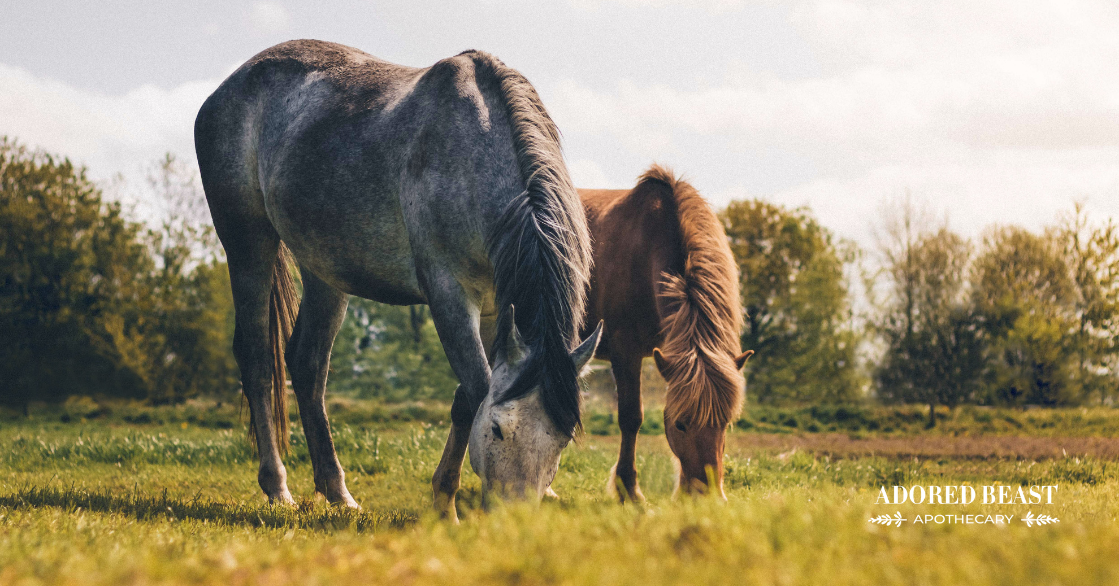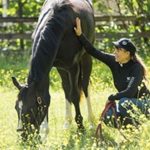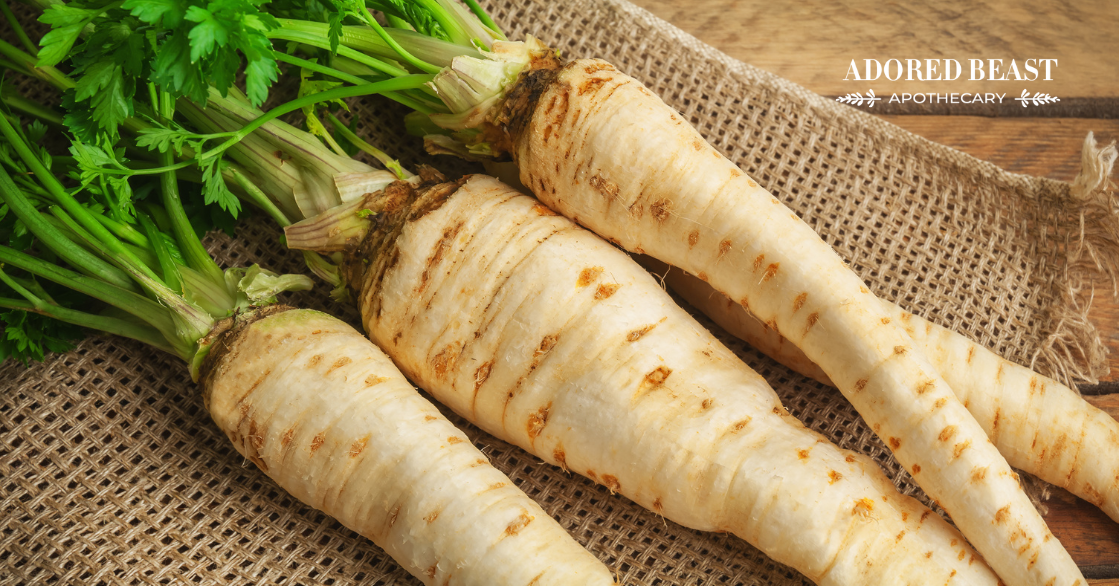Laminitis in horses is a heartbreaking illness that affects approximately 10-15% of equines in North America, according to the USDA. In fact, new research out of Britain shows that laminitis is as common as colic in horses in that region. (1)
Veterinarians and experts still understand very little about the development of this disease other than acknowledging a set of commonalities between diagnosed horses.
Today, I want to discuss this from a higher level to see where things can go wrong, how you can help prevent laminitis, and what you might be able to do beyond conventional measures. Please note that if cases are severe, there may be no single solution that will work. Be sure you’re always keeping your horse’s quality of life at the top of the priority list.
What is Laminitis in Horses?
Laminitis is a destructive, painful condition causing inflammation and separation of the laminae tissue from the pedal bone in the hoof. In severe cases, it can cause sinking and rotation of the pedal bone and can lead to animals having to be euthanized. It is important to understand that laminitis is a systemic disease, not localized to the legs of the horse. It involves the cardiovascular, endocrine, and immunologic systems. (2)
Types of Laminitis
There are 3 types of laminitis in horses:
1. Inflammatory-Associated Laminitis
The most common cause of inflammatory laminitis is grain or non-structural carbohydrate (NSC/starch) overload. Horses are EXTREMELY – and I mean, extremely – sensitive to dietary sugar. Ponies and donkeys are even more sensitive, which is why we see so much laminitis with them.
Medical texts recognize the sudden increase in grain consumption as a major cause of systemic inflammation and laminitis. That said, we are going to talk further about how this can actually be a chronic issue that happens over time, as well as the issue of insulin getting dysregulated over time and eventually reaching a breaking point. Vaccination can also be a cause of acute laminitis since it causes systemic inflammation. Some medications can also put your horse at risk for laminitis, including dexamethasone (keep reading to learn how).
2. Overload/Supporting Limb Laminitis
This is a condition that occurs when lameness in the hind limbs causes excessive weight-bearing on the front limbs, causing a significant decrease in blood flow around the hoof. It can also happen from improper farrier work so it’s extremely important to ensure that you have a farrier that understand your horse’s needs in this aspect, even in relation to other types of laminitis. Obesity is another contributing factor to this particular type of laminitis and endocrine laminitis (see below).
3. Endocrine/Endocrinopathic Laminitis
This is the most common and most misunderstood type of laminitis. Two diseases have been largely associated with endocrine-related laminitis: insulin resistance or equine metabolic syndrome (IR or EMS) and PPID (Cushing’s disease). These diseases predispose horses to laminitis because they dysregulate their ability to control carbohydrate metabolism.
Medical documents will often point to the horse’s inability to control sugar as the major cause of elevated blood insulin. But, it’s a chick or egg scenario – is it the insulin causing the issue, or carbs, or is there an underlying inflammatory factor? What is underlying this miscommunication of the metabolism? The endocrine function of horses is poorly understood, even by the experts. There are several causes of metabolic disease in horses and often times, multiple factors playing a role. By putting all the puzzle pieces together, we can make good preventative and care decisions for horses struggling with this disease.
Causes of Laminitis in Horses
What if I told you grass is not the problem…
It’s true. Grass isn’t really the problem. It’s a horse’s individual ability to regulate non-structural carbohydrate (NSC) metabolism and insulin. This process can become dysregulated for a number of reasons that will be discussed below. So, grass can appear to be the situational culprit in the onset of laminitis, but it is simply the last straw for an already vulnerable horse.
Research has brought to light several aspects of the development of laminitis in horses. Previously misunderstood causes are becoming more apparent in the development of this painful inflammatory disease:
Arguably the BIGGEST Cause of Laminitis – Stress!
I can’t STRESS it enough, but this is the number one cause of all chronic disease. Stress has the ability – in a body that’s barely maintaining homeostasis – to tip the scales into the danger zone. Heightened cortisol is a direct result of stress and is well known as a contributing factor in a number of equine inflammatory diseases, including laminitis. Systemic chronic inflammation will naturally cause cortisol to rise because inflammation causes this response in the body. Let’s not blame it all on cortisol, though, because cortisol works as a natural anti-inflammatory hormone, reducing inflammation in an intelligent manner and restoring homeostasis – but only in an intelligent and healthy system.
In a chronically stressed, chronically inflamed system, cortisol can go into overdrive and cause havoc. Horses diagnosed with Cushing’s disease have chronically-elevated levels of cortisol in the bloodstream due to dysregulation of adrenal and pituitary metabolism. Prolonged heightened cortisol can also happen during ongoing stressful environmental situations, from lack of sleep and synthetic glucocorticoid medications such as dexamethasone (DEX) and tricinolone. (3) (4) (5) One study shows that an enzyme associated with cortisol conversion has been found in elevated concentrations in the lamellar and subcutaneous tissues of horses with laminitis, suggesting cortisol dysregulation. Naturally-occurring and synthetic glucocorticoids have been proven to cause degeneration and loss of tendon strength in a number of animals, including dogs and horses. Horses with Cushing’s in the same study were shown to have similar systemic cortisol levels as horses treated with synthetic steroids like DEX. (6) So, whether or not your horse has Cushing’s, stress is a defining factor in whether your horse will develop laminitis. Paired with other known causes, it can be a recipe for disaster.
Immunologic Hyper-reactivity/Routine Vaccination
A lesser known, but equally important, puzzle piece that needs to be discussed more often is that the immune system can become hyper-reactive when the endocrine system isn’t working properly. Horses with metabolic disease and Cushing’s disease do not have full function of their immune systems.
Horses, in general, are vaccinated more often than any other domesticated animal in North America. And it might be time to start re-thinking this practice.
Vaccinations cause a hyper-immunologic (inflammatory) response to “force” the immune system into producing antibodies. This can also lead to extreme systemic inflammation in immunologically sensitive horses, sometimes to the point of anaphylaxis, but it occurs more frequently in lesser states that sometimes go unnoticed or unrecognized as a problem. We all know a horse that is sick for several days after receiving their vaccines – often localized swelling can be seen – but the systemic affect is invisible to the naked eye.
A study from Texas A&M University found that horses with laminitis were significantly more reactive to a large variety (70) allergens than healthy horses, suggesting they should only be vaccinated with extreme caution or not at all. (7) Even if your horse has never had laminitis, consider the inflammatory effects that frequent vaccines can have on your horse, especially if they have already been diagnosed with some form of inflammatory illness, insulin resistance, or Cushing’s. Consider titer testing your horse instead of vaccination once they have received their initial shots to save your horse the stress of yearly (or more frequent) inflammatory stress.
Improper Shoeing/Trimming
Your farrier shouldn’t be totally to blame for a laminitis flare up, but they certainly can help or hinder. Horses that are on the edge already are the ones most likely to succumb to laminitis after a trim from the farrier. The trim is merely the tipping point. The main reasons for this are:
- Trims are not frequent enough and the angle of your horse’s feet change too dramatically during trimmings. If you are seeing lameness in your horse after your farrier has come, consider trimming your horse more frequently. Additionally, if changes are needed to correct the angles, they need to be done very gradually. Lameness after trimming should be taken seriously, especially if it’s happened more than once. Lameness after trims could also be associated with already underlying inflammation in the foot, which becomes exacerbated by a significant change in the angle of the lamellar tendons. It’s important not to blame the farrier, but rather to consider that your horse might need help reducing the inflammation in their body.
- If your horse has been recently vaccinated, they are in a state of acute inflammation. A trim could cause excess stress on the tendons and has been known to induce laminitis episodes (known as chemically-induced laminitis).
Microbiome Imbalance/Antibiotic Use/Dysbiosis
In human science, it has been established that the gut microbiome plays a role in the development of insulin resistance. The alternation of biodiversity in the gut can interfere with intestinal permeability, which increases absorption of lipopolysaccharides, initiating metabolic pathways that increase the activation of inflammatory pathways.(8) With laminitis for horses, research shows that in sugar-induced laminitis, the microbiome of the hindgut was altered – and horses had lower fecal pH but higher lactic acid, histamine and lipopolysachharides in their blood serum. Another study shows that horses with metabolic syndrome had significantly lower microbiome diversity than those of healthy horses. (9)
Antibiotic use/overuse can affect your horse’s hindgut microbial community. Dysbiosis (a disturbance in the microbiome) can occur, increasing pathogenic (inflammatory) strains (including E. coli, C. perf and C. diff) and decreasing strains known to be more abundant in healthy horses vs. laminitis horses. (10)
Insulin and the Lamellar Tissue
Another extremely under-rated discovery that researchers have made is that there may be a mis-communication in the metabolism of insulin-like growth factor (IGF), a hormone that regulates hair and goof growth. Researchers have discovered that when insulin gets elevated for long periods of time, it may affect/dysregulate the IGF receptors. They become confused and begin to misinterpret and uptake insulin instead of IGF, causing excessive hair and lamellar growth. (11)
What You Can Do to Help Your Horses and Ponies
The names of the game here are:
- Stress Reduction – This is one of the most important pieces in preventing laminitis in horses, and flare ups if your horse has already had an episode. Check out our Equine Metabolic Syndrome article to learn tips and tricks for stress/cortisol reduction.
- Diet Optimization – A high fibre/forage, low sugar (NSC) diet is extremely important for all horses but, especially for insulin-resistance horses and horses with inflammation. Glyphosate (AKA Roundup) should also be completely removed from the diet. It is a patented antibiotic, known metabolic disruptor, and cancer-causing/inflammatory agent that no horse should be eating. Probiotics can help to diversify the microbiome and access to small amounts of dirt and living forage can help to do this as well. Even 10-15 minutes of grazing can help diversify your horse’s microbiome. Diversifying the types of forage your horse has access to (including nutritive herbs) can make a huge difference in the biodiversity of your horse’s gut.
- Movement – Apart from your regular riding exercises, be sure your horse has the ability to move around in the form of low-impact movement. Hand walking, in/out paddock designs, and providing multiple hay stations can increase movement, which increases blood flow, regulates insulin, and also reduces cortisol. Properly managed pasture should be included as your horse’s health improves but only if you can ensure correct management of your fields is maintained.
- Avoid Antibiotics, NSAIDs, and Steroids – Unless completely necessary! Protect your horse’s endocrine system and their microbiome.
- X-Ray-Guided Trimming – Having your vet and your farrier involved to help relieve any pressure the front limbs might be experiencing due to abnormal angles in the feet can help to prevent and improve laminitis.
- Gut Supportive Herbs – Herbs like marshmallow root, slippery elm, and liquorice root can all improve gastrointestinal and microbiome health and help with blood sugar regulation.
- Medicinal Mushrooms – Chaga and turkey tail mushrooms contain potent anti-inflammatory properties and have the ability to improve blood sugar balance.
Most of the time, there are multiple causes and solutions for horses that are in any stage of developing laminitis. Each horse is an individual and should be treated as such, always ALWAYS keeping their quality of life at the top of the priority list.
References
- Equine Veterinary Journal: Incidence and clinical signs of owner-reported equine laminitis in a cohort of horses and ponies in Great Britain, 2018
- Veterinary Clinics of North America: Equine Practice: Laminitis is a systemic disease, 1999
- Equine Veterinary Journal: Seasonal and annual influence on insulin and cortisol results from overnight dexamethasone suppression tests in normal ponies and ponies predisposed to laminitis, 2013
- Compendium: Glucocorticoids and laminitis in horses, 2004
- Equine Veterinary Education: Glucocorticoid therapy and the risk of equine laminitis, 2013
- AVMA Journal: Assessment of tissue-specific cortisol activity with regard to degeneration of the suspensory ligaments in horses with pituitary pars intermedia dysfunction, 2018
- The Horse: Linking Chronic Laminitis to Immunologic Hyperreactivity, 2003 (Wagner, I.P.; Rees, C.A.; Dunstan, R.W.; et al. American Journal of Veterinary Research 64 (3), 279-283, 2003.)
- Nutrients: The role of gut microbiota in insulin resistance, 2013
- Journal of Equine Veterinary Science: Comparison of the fecal microbiota of horses with equine metabolic syndrome and metabolically normal controls fed a similar all-forage diet, 2016
- University of Southern Illinois, Department of Animal Science: Role of the gut microbiota in equine health and disease, 2016
- The Horse: Grasping insulin resistance in horses, 2019












